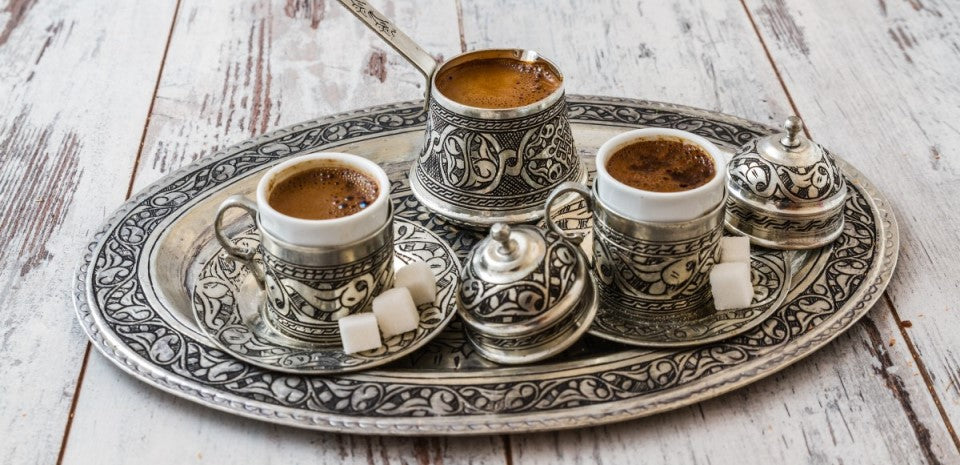Tasseography is a fortune-telling method that interprets patterns in tea leaves, coffee grounds, and even wine sediments. For centuries, the art of reading Turkish coffee grounds has been a tradition in countries that prefer Turkish coffee (not just Turkey). Some people read Turkish coffee grounds for serious results, some read them simply for fun. Either way, it's a great way to immerse yourself in another culture and sip on some delicious coffee.

Here's what you'll need:
- J.L. Hufford Turkish Blend Coffee is the best to use, but you can use any blend you would like (use the code COFFEE10 to save 10% when you buy from our vast collection of coffee beans!).
- A white cup and saucer - we recommend the notNeutral LINO Latte Cup and Saucer for this.
- A traditional Turkish coffee pot.
Rules and Advice:
- The coffee should be finely blended, so no chunks dilute the grounds. You can read our blog post about how to make the best Turkish coffee for more details.
- Feel free to add an extra tablespoon of coffee powder for more grounds to read.
- You shouldn't read your own grounds, as you will probably be biased. You can read your own as practice for visualizing symbols, though.
- Always start from the cup’s handle. You move from right to left if the person is right-handed or left to right for left-handed.
Cup preparation:
- Make sure to sip from the same side, and drink it casually. There's no need to rush.
- Leave a small amount left in the cup, about one sip's worth, and swirl it around so the sediments get loose.
- Take the final sip, and then make a wish.
- Place the saucer over the top of the cup (face on) to cover it. Make sure that you seal it very well.
- Hold the coffee cup set with your hands in front of you, chest level.
- Make 3 horizontal circles clockwise. Your goal is to move the sediment around and evenly spread it around the entire inside surface of the cup.
- Turn the coffee cup set upside down (flip it) with a quick movement. This action will bring the sediments down to the saucer, leaving the necessary patterns that a coffee reader needs.
The Coffee Reader:
- The reader leaves the cup for 5 to 10 minutes to drain completely and cool. The sediments will slowly slide in the saucer and will create the final patterns inside the cup.
- If you prefer to investigate relationships you put a ring on the back surface of the cup.
- If the reading session is about money then you must put a coin on the back surface of the cup.
- The reader returns you any object that you have put on the cup. Then, they gently separate the cup from the saucer.
- If a big chunk of grounds falls on the saucer, it means that any of your troubles or worries will leave you soon.
- If the fallen ground forms a pile, it means money will come your way.
- If the cup and saucer are tight and the reader can lift them up as one unit, it’s a Prophet's Cup. This means you don’t need to proceed with reading because all of your readings will come true. Most people still continue with the reading anyway, for fun.
- The coffee reader overturns the cup and holds it upright. The shapes inside the cup and the saucer will constitute some meanings deserving explanation

Cup Division:
-
The Five Section Division is the most common way of dividing the cup, but whatever feels natural and instinctive is best as well.
-
Handle side (left or right depending on which hand it was held in) = Love life related events
-
Front rim side (the side opposite the handle) = financial and wealth related matters
-
Bottom (bowl) of cup = home life and family affairs
-
Upper rim (upper side between handle and "front" rim) = present life
-
Lower rim (lower side between handle and "front" rim = future life
Reading the Symbols:
- Reading symbols relies heavily on the reader's interpretation and instinct.
- If you recognize an image in the cup, what is your gut feeling about it? If it resembles a symbol you know, what is commonly associated with that symbol?
- Here is a list of common symbols in tasseography, but again - the reading relies heavily on the reader's gut reaction and interpretation.
Many people leave the reading feeling good about the future. Whether divination is something you believe in or not, it can be fun and educational to give tasseography a try. Gather up some friends, make some great coffee, and try reading each others' fortunes! Tag us on Instagram (@jlhuffordcoffee) to let us know how it goes!
. . .
J.L. Hufford Coffee & Tea Company was founded in 1991 by owners Joe and Wrena Hufford, who were inspired during a vacation to Seattle. The Tippecanoe Mall in Lafayette, Indiana has been our brick-and-mortar coffee shop's permanent home for over 25 years.


